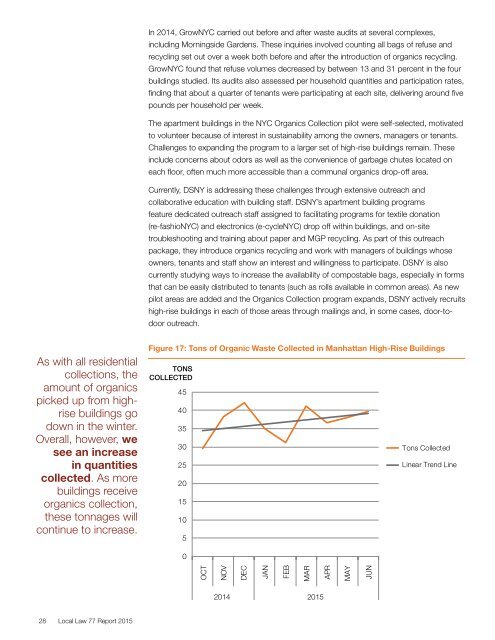2015 NYC Organics Collection Report
1jcwPY1
1jcwPY1
You also want an ePaper? Increase the reach of your titles
YUMPU automatically turns print PDFs into web optimized ePapers that Google loves.
In 2014, Grow<strong>NYC</strong> carried out before and after waste audits at several complexes,<br />
including Morningside Gardens. These inquiries involved counting all bags of refuse and<br />
recycling set out over a week both before and after the introduction of organics recycling.<br />
Grow<strong>NYC</strong> found that refuse volumes decreased by between 13 and 31 percent in the four<br />
buildings studied. Its audits also assessed per household quantities and participation rates,<br />
finding that about a quarter of tenants were participating at each site, delivering around five<br />
pounds per household per week.<br />
The apartment buildings in the <strong>NYC</strong> <strong>Organics</strong> <strong>Collection</strong> pilot were self-selected, motivated<br />
to volunteer because of interest in sustainability among the owners, managers or tenants.<br />
Challenges to expanding the program to a larger set of high-rise buildings remain. These<br />
include concerns about odors as well as the convenience of garbage chutes located on<br />
each floor, often much more accessible than a communal organics drop-off area.<br />
Currently, DSNY is addressing these challenges through extensive outreach and<br />
collaborative education with building staff. DSNY’s apartment building programs<br />
feature dedicated outreach staff assigned to facilitating programs for textile donation<br />
(re-fashio<strong>NYC</strong>) and electronics (e-cycle<strong>NYC</strong>) drop off within buildings, and on-site<br />
troubleshooting and training about paper and MGP recycling. As part of this outreach<br />
package, they introduce organics recycling and work with managers of buildings whose<br />
owners, tenants and staff show an interest and willingness to participate. DSNY is also<br />
currently studying ways to increase the availability of compostable bags, especially in forms<br />
that can be easily distributed to tenants (such as rolls available in common areas). As new<br />
pilot areas are added and the <strong>Organics</strong> <strong>Collection</strong> program expands, DSNY actively recruits<br />
high-rise buildings in each of those areas through mailings and, in some cases, door-todoor<br />
outreach.<br />
As with all residential<br />
collections, the<br />
amount of organics<br />
picked up from highrise<br />
buildings go<br />
down in the winter.<br />
Overall, however, we<br />
see an increase<br />
in quantities<br />
collected. As more<br />
buildings receive<br />
organics collection,<br />
these tonnages will<br />
continue to increase.<br />
Figure 17: Tons of Organic Waste Collected in Manhattan High-Rise Buildings<br />
TONS<br />
COLLECTED<br />
45<br />
40<br />
35<br />
30<br />
25<br />
20<br />
15<br />
10<br />
5<br />
Tons Collected<br />
Linear Trend Line<br />
0<br />
OCT<br />
NOV<br />
DEC<br />
JAN<br />
FEB<br />
MAR<br />
APR<br />
MAY<br />
JUN<br />
2014 <strong>2015</strong><br />
28 Local Law 77 <strong>Report</strong> <strong>2015</strong>


